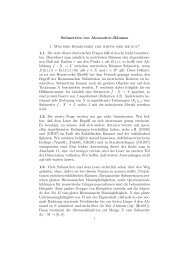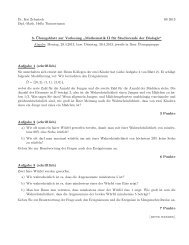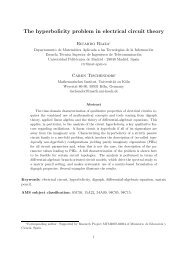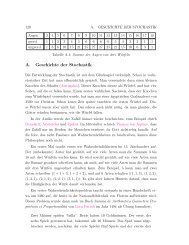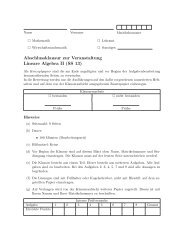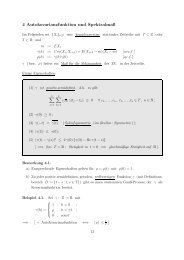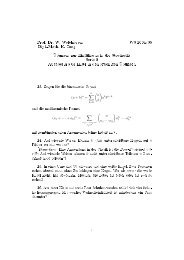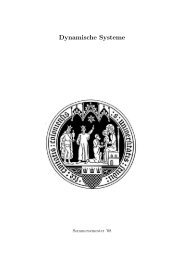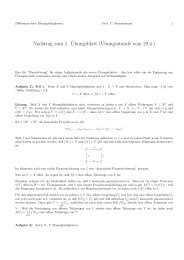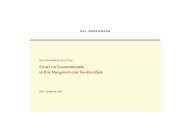Inhaltsverzeichnis - Mathematisches Institut der Universität zu Köln
Inhaltsverzeichnis - Mathematisches Institut der Universität zu Köln
Inhaltsverzeichnis - Mathematisches Institut der Universität zu Köln
Create successful ePaper yourself
Turn your PDF publications into a flip-book with our unique Google optimized e-Paper software.
DMV Tagung 2011 - <strong>Köln</strong>, 19. - 22. September<br />
Silvia Daun–Gruhn, Tibor I. Tóth<br />
Emmy-Noether Research Group, Zoological <strong>Institut</strong>e, University of Cologne<br />
A model of the levator-depressor neuro-mechanical system of the stick insect leg<br />
It has been established experimentally that each joint in the stick insect leg is associated with its own<br />
rhythm generating neural network (CPG), which is responsible for driving the motoneurons (MNs) that<br />
innervate antagonistic muscle pairs [1]. This arrangement ensures large flexibility of the leg movements<br />
in these animals. But how exactly do these CPG-MN-muscles systems function? And how is sensory<br />
information integrated to produce functional stepping?<br />
To tackle these questions, we developed a mathematical model of the levator-depressor neuro-mechanical<br />
system, which consists of a half-center oscillator [2] that controls the MN activity via inhibitory interneurons<br />
[3]. A sensory pathway to the CPG, conveying information on the loading of the leg, is included<br />
as well. The core of the mechanical model is the equation of motion of the femur. The muscles are<br />
modeled as nonlinear springs with variable elasticity modules and with viscous damping parallel to the<br />
springs. Finally, the neural and the muscle systems are coupled by a linear, 1st or<strong>der</strong> synapse model [4].<br />
Our model successfully reproduces the MN activities, as well as the angular movement of the femur as<br />
recorded during straightforward locomotion. Furthermore, our simulations provide strong evidence for a<br />
high behavioral flexibility of the model un<strong>der</strong> various peripheral or central influences.<br />
Literatur<br />
Büschges, A., Schmitz, J., Bässler, U. (1995). Rhythmic patterns in the thoracic nerve cord of the stick<br />
insect induced by pilocarpine. J Exp Biol, 198, 435 - 456.<br />
Daun, S., Rybak, I.A., Rubin, J. (2009). The response of a half-center oscillator to external drive depends<br />
on the intrinsic dynamics of its components: a mechanistic analysis. J comput Neurosci, 27, 3 - 36.<br />
Daun-Gruhn, S., Toth, T.I. (2010). An inter-segmental network model and its use in elucidating gaitswitches<br />
in the stick insect. J comput Neurosci, doi:10.1007/s10827-010-0300-1.<br />
Toth, T.I., Bessaih, T., Leresche, N., Crunelli, V. (2007). The properties of reticular thalamic neuron<br />
GABA_A IPSCs of absence epilepsy rats lead to enhanced network excitability. Eur J Neurosci, 26, 1832<br />
- 1844.<br />
169




